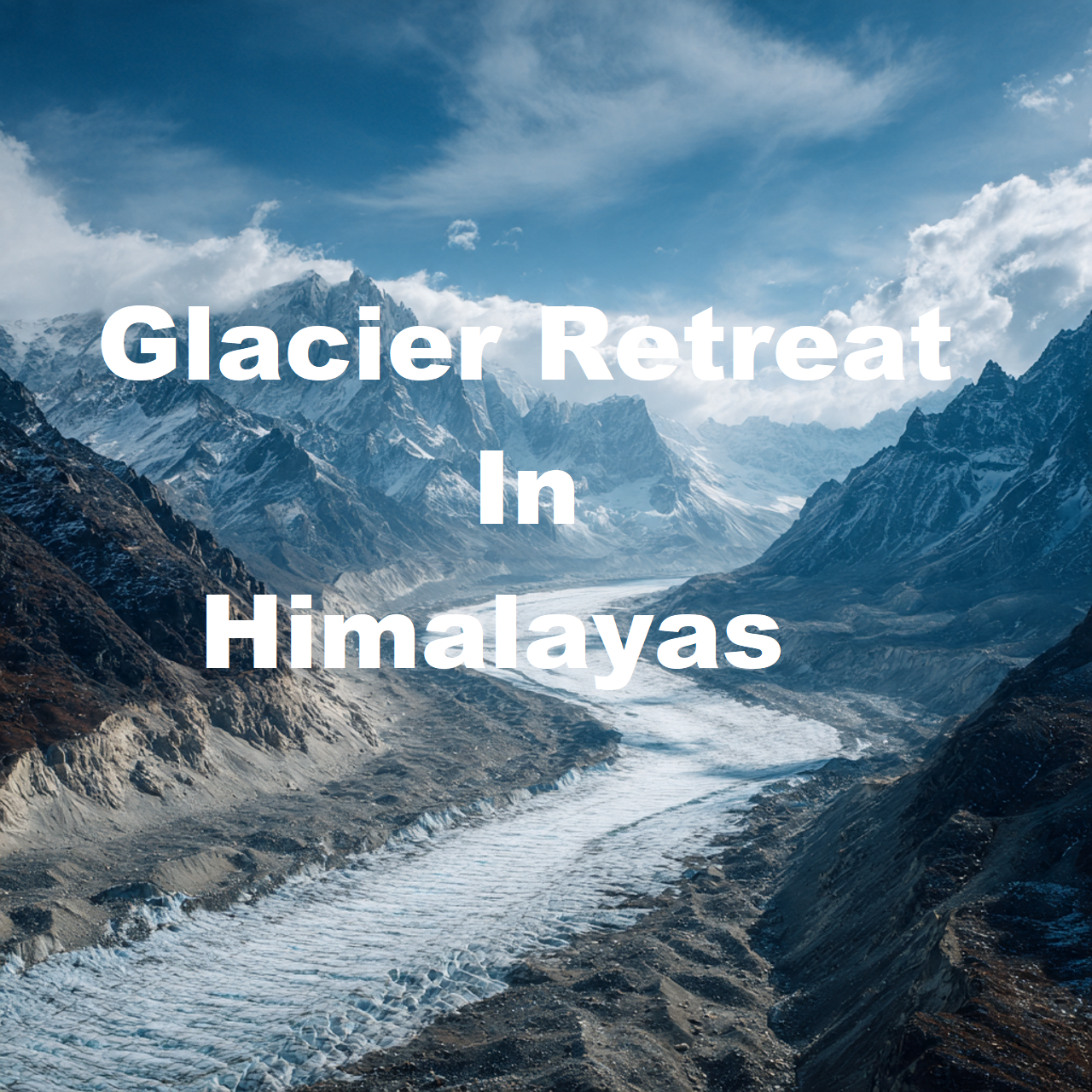Glacier Retreat in Himalayas: the Impact of Climate Change
Glacier retreat in Himalayas is the most visible manifestation of climate change in recent decades. Himalayan glaciers are melting at an alarming rate, and scientists are tracking it continuously to find out its effects. First, increased temperatures are accelerating the melting of ice and snow, which has a direct effect on freshwater supply in main rivers such as the Ganga and Brahmaputra. Furthermore, glacial lake outburst floods are a greater risk in glacier retreat, endangering the communities and infrastructure around it. Therefore, policymakers stress sustainable water management and climate adaptation. Besides, research reveals that human activities like deforestation and greenhouse gas emissions also cause glacier retreat. Hence, UPSC aspirants need to pay special attention to environmental, social, and economic impacts of glacier loss while studying current affairs questions.
Last but not least, the topic usually accompanies typical FAQs like “What causes glacier retreat? ” or “How does it affect rivers and agriculture?”undefined” Knowing these subtleties enables candidates to reply confidently in interviews and exams.
What Is Glacier Retreat and Why It Matters in the Himalayas?
Glacier retreat happens when a glacier melts and recedes quicker than it can gain new ice. In the Himalayas, an increase in temperatures and unstable weather patterns quicken the process, resulting in glaciers losing mass at a brisk pace. Scientists find that the Himalayan glaciers, which supply big rivers like the Ganga, Yamuna, and Brahmaputra, are retreating at a faster rate than ever. This retreat immediately cuts off the long-term water supply for millions of individuals relying on glacial meltwater for drinking, irrigation, and hydropower. Mountain communities are threatened by flash flooding, landslides, and loss of productive land as melting ice undermines the landscape. This is an issue that policymakers and researchers observe closely because glacier melting in the Himalayas does not only indicate the extent of climate change, but it also shows the imperative need to implement sustainable adaptation strategies. Saving the glaciers equates to saving lives, ecosystems, and local economies.
Causes of Glacier Retreat in Himalayas: Climate Change and Human Activity
Scientists pinpoint climate change as the main cause of glacier recession in the Himalayas. Global warming results in the melting of ice at a rate higher than that of snowfall to replace it, resulting in a consistent decrease in glacial mass. Warming also affects monsoons, which lowers snowfall and enhances melting. Human activities add to the situation. Humans burn fossil fuels, emit greenhouse gases, and deposit more air pollution, adding heat to the atmosphere. Black carbon from fossil-fuel emissions and biomass burning settle on snow, causing glaciers to absorb more solar radiation and melt rapidly. Forest loss in mountain areas diminishes natural cooling and undermines ecological resilience. Construction of roads and dams, rapid urbanization, and unregulated tourism disrupt fragile slopes and enhance local warming. Together, human activities and climate change force glacier retreat in the Himalayas, posing a danger to water security, ecosystems, as well as millions of people whose survival largely depends on glacial rivers.
Rising Temperatures and Their Effect on Himalayan Glaciers
Increased temperatures in the Himalayas speed up glacial melting at a critical pace. Researchers document that mean temperatures around the region have risen dramatically in recent decades, directly lowering the mass of glaciers. Warmer temperatures speed up ice melting in summer and decrease the duration of snowfall accumulation in winter. Shrinkage in glaciers discharges more meltwater, which can lead to flash flooding and rockslides on slopes. The retreat also decreases the volume of rivers that are utilized by millions of individuals for drinking, irrigation, and hydropower. Local environments deteriorate as organisms that depend on cold climates fail to adapt. In general, increased temperatures propel glacier retreat in the Himalayas, emphasizing the imperative necessity to develop climate mitigation and adaptation policies.
Impact of Glacier Retreat on Himalayan Rivers and Water Resources
Himalayan glacier retreat impacts rivers and water resources directly in northern India and the surrounding countries. When glaciers melt, they first release surplus meltwater, making rivers swell and heightening the threat of flash floods. With time, the diminished glacial mass lowers the natural source of meltwater, making river flows decrease, particularly in dry periods. The populations of rivers like the Ganga, Yamuna, Brahmaputra, and Indus have to endure water scarcity for drinking, irrigation, and hydropower. Agriculture is also affected as water supply to irrigation channels decreases, and hydropower plants produce less electricity. Aquatic ecosystems and wildlife suffer from fluctuating water levels and temperatures. Policymakers, researchers, and local governments actively monitor such effects to design adaptive measures, including building reservoirs, encouraging water conservation, and enhancing flood control systems. The melting of Himalayan glaciers thereby imperils human sustenance as well as local water security.
Consequences for Agriculture and Livelihoods in Mountain Communities
As Himalayan glaciers retreat, mountain livelihoods and agriculture suffer drastically. First, the farmers suffer as decreased glacial melt reduces river flows, limiting irrigation water directly. Hence, crop yields lower, and food insecurity increases. Additionally, erratic rainfall patterns disrupt indigenous planting cycles, compelling farmers to quickly adjust. Furthermore, livestock deteriorates due to diminished pasture and limited water sources, further weakening household incomes. In addition, communities that depend on tourism, trekking, and handicrafts suffer economically due to shifting landscapes and environmental risks that scare away visitors. Consequently, most families are in economic distress, leading to migration to cities. Nevertheless, some communities do implement innovative techniques, including water-harvesting practices, climate-proof crops, and collaborative farming. Generally, glacier withdrawal in the Himalayas poses a risk not just to agriculture but also to complete livelihoods, further emphasizing the need for sustainable adaptation strategies and government assistance.
Glacier Retreat in Himalayas and the Risk of Natural Disasters
Himalayan glacier retreat seriously enhances the risk of natural hazards in the region. With the rapid melting of glaciers, they create unstable glacial lakes that may burst suddenly, leading to disastrous floods downstream. As a result, villages and towns on riverbanks are directly threatened by loss of life and property. Further, melting glaciers destabilize mountain slopes, which frequently causes landslides and debris flows. In addition, diminutive snow cover and changing water patterns enhance soil erosion, further destabilizing slopes and making them more vulnerable to disasters. In addition, intense weather events like heavy rainfall and heatwaves amplify the impacts of glacier recession, producing compound hazards. Consequently, local governments and communities have to initiate early warning systems, enhance flood protection, and institute sustainable land-use management. Finally, Himalayan glacier retreat not only indicates environmental change but also directly increases the chances of natural disasters and makes disaster preparedness an imperative in the region.
Biodiversity Loss in Fragile Mountain Ecosystems
Retreat of glaciers in the Himalayas leads to vast loss of biodiversity in vulnerable mountain environments. When ice and snow melt, alpine ecosystems decrease, and several cold-resistant species find it challenging to exist. As a result, endangered animals like snow leopards, Himalayan tahrs, and some migratory birds experience habitat fragmentation, declining their number. Apart from this, vegetation species that rely on glacial melt and cold environments dwindle, leading to disturbance of the food chain and balance of nature. Additionally, shifts in water availability modify riverine and wetland ecosystems, impacting fish and amphibians. In addition, invasive species easily exploit the change, forcing out indigenous flora and fauna. As a result, scientists and conservationists call for immediate action, including restoration of habitats, extended protected areas, and community-based conservation initiatives. Generally, glacier retreat in the Himalayas poses as much threat to water as it does to the biodiversity which supports both ecosystems and local communities.
Scientific Studies and Evidence of Glacier Retreat in Himalayas
Researchers have carried out large-scale studies to report the retreat of glaciers in the Himalayas, and their reports demonstrate ominous trends. First, satellite images and aerial photography evidently indicate that most glaciers have lost a lot of their mass during the last few decades. Second, field measurements, including ice core drilling and glacial mass balance experiments, offer tangible data of increasing melting. Additionally, scientists note that increasing temperatures and shifting precipitation levels directly correspond to the pace of glacial loss. Additional comparative examinations of past maps and current data substantiate long-term glacial retreat. Thus, the research emphasizes not only the rate of retreat but also its ripple impact on rivers, ecosystems, and human societies. Thus, scientists promote urgent responses, including climate mitigation measures and policy interventions. In general, scientific research always shows that glacier melting in the Himalayas is a key indicator of local and global climatic change.
Government Policies and Adaptation Strategies in India
Himalayas. First, governments have climate action plans in place both at the national and state levels to check greenhouse gas emissions and encourage the use of renewable energy. Additional schemes like watershed management and plantation activities assist in maintaining ecological balance and stabilizing the mountain slopes. Secondly, the government invests in the early warning system for landslides and floods, which have a direct benefit of safeguarding communities downstream of glacial melts. In addition, government-sponsored research activities track glacier changes and offer essential information for sustainable water planning. For this reason, local populations are trained in climate-resilient agriculture, disaster management, and water-saving practices. Together, these efforts overall reflect India’s proactivity: through interlinking scientific research, policy intervention, and community engagement, the government not only reduces the impacts of glacier retreat but also enhances mountain ecosystems and human population resilience.
Future Outlook: Can Himalayan Glaciers Be Saved?
First and foremost, scientists point out that urgent worldwide action on climate change can retard the retreat of glaciers in the Himalayas.
Secondly, cutting greenhouse gas emissions globally directly restricts additional temperature increase, which shields glacial mass.
Thirdly, governments can enact stronger environmental regulations, including an increase in renewable energy and control over industrial pollution.
Fourthly, local communities can practice sustainable agriculture to ease the burden on weak mountain ecosystems.
Simultaneously, afforestation and reforestation initiatives stabilize slopes and mitigate glacier melt-induced soil erosion.
Early warning systems for glacial lake outburst floods are also suggested by scientists in order to safeguard human life and assets.
Research and glacier monitoring also offer essential inputs for successful planning and adaptation measures.
Global cooperation, such as sharing technology and financial resources, may further enhance climate mitigation measures in Himalayan nations.
Public campaigns promote people to minimize carbon footprints and fund conservation efforts.
Finally, the synergy between scientific studies, government policies, local people’s involvement, and international action can enhance the prospects, allowing Himalayan glaciers an opportunity to endure for the next generations.
Commonly asked UPSC interview questions
Question: What is glacier retreat in the Himalayas?
Answer: Glacier retreat is the melting and reduction of glaciers more rapidly than they can gain ice, causing a decline in glacial mass.
Question: What are the primary reasons behind glacier retreat in the Himalayas?
Answer: Increased temperatures from climate change, black carbon deposition, changed precipitation patterns, and human activities like deforestation and pollution.
Question: How does glacier retreat influence rivers in northern India?
Answer: Glacier retreat diminishes long-term meltwater supply, leading to fluctuating river flows, water scarcity during dry periods, and enhanced flood hazard in summer.
Question: Which groups are most impacted by Himalayan glacier retreat?
Answer: Mountain communities that depend on glacial melt for irrigation, drinking water, hydropower, and livelihoods like agriculture, livestock, and tourism.
Question: What can India do to combat glacier retreat?
Answer: India can launch climate action plans, advance renewable energy, enhance disaster management, help sustainable mountain livelihoods, and develop expanded research and monitoring programs.
FAQ in UPSC on Glacier Retreat in Himalayas
Question: In what way do black carbon emissions advance glacier retreat?
Answer: Black carbon from transportation, industry, and biomass burning accumulates on glacier surfaces, traps sunlight, and hastens melting of the ice.
Question: Identify two significant Himalayan rivers impacted by glacier retreat.
Answer: The Ganga and Brahmaputra rivers experience altered flows because of decreased glacial melt.
Question: What is a glacial lake outburst flood (GLOF)?
Answer: A GLOF occurs when a glacial lake suddenly bursts, resulting in floods and destruction of downstream settlements.
Question: How does glacier retreat affect agriculture in northern India?
Answer: Decreased river flows and irregular supply of water disturb irrigation, resulting in decreased yields of crops and food security issues.
Question: Provide one scientific technique to research glacier retreat.
Answer: Satellite remote sensing is employed to track glacial retreat over years.
Question: In what ways does climate change indirectly impact Himalayan biodiversity?
Answer: Glacier melting decreases cold habitats, fragments ecosystems, and endangers species such as snow leopards and Himalayan tahrs.
Conclusion:
To sum up, Himalayan glacier retreat remains a tremendous threat to rivers, agriculture, biodiversity, and mountain societies. Therefore, policymakers and scientists are stressing immediate action to control climate change and adopt successful adaptation measures. Additionally, local societies must take an active role by embracing sustainable methods, including water conservation, climate-resilient agriculture, and afforestation. Besides, government programs, early warning systems, and research schemes render support of critical importance to risk management and livelihood protection. Furthermore, global cooperation and awareness-raising programs assist in reinforcing worldwide efforts to impede glacier melt. Thus, despite the enormity of the challenges, collaborative science, policy, and community action hold promise for safeguarding these essential mountain ecosystems. Finally, the loss of the Himalayan glaciers is a stern warning of environmental transition that should challenge everyone to act in time. With that much at stake, what are you prepared to do to save these vulnerable glaciers?





0 Comments